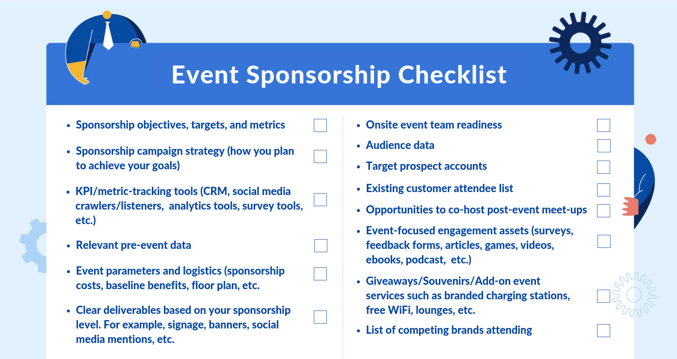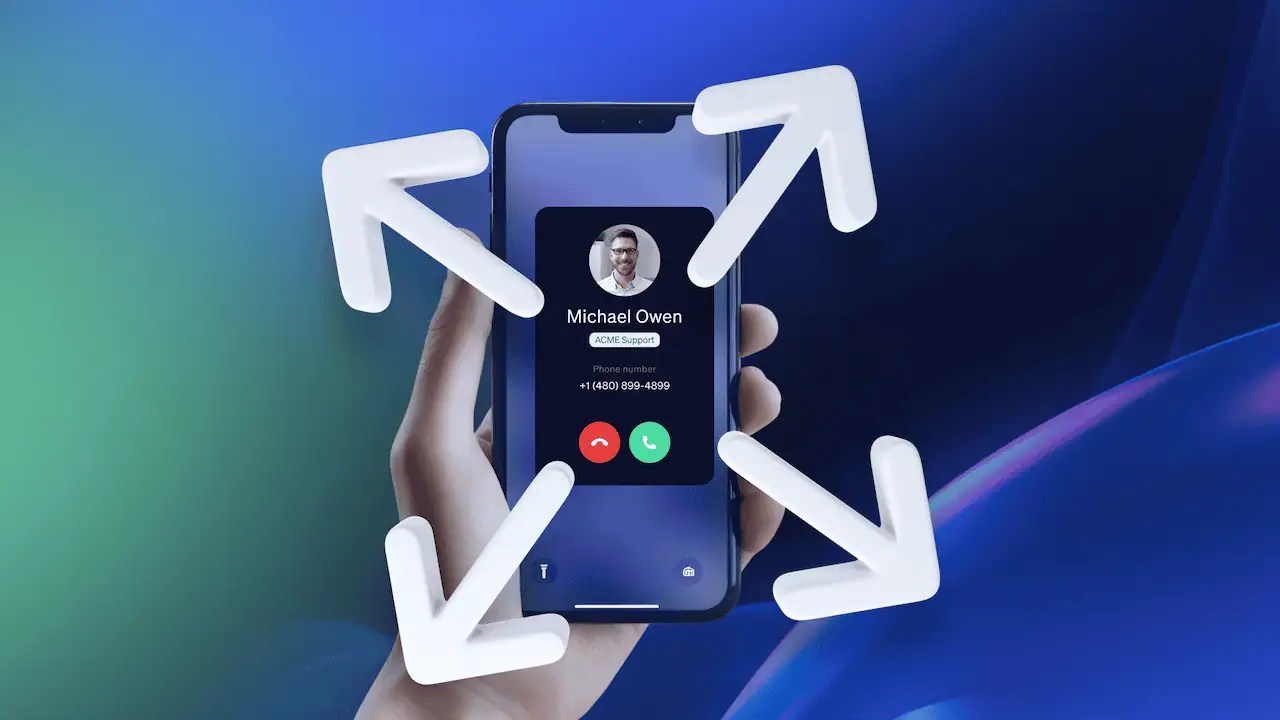When done right, event sponsorship delivers on its promise. It will help your brand gain visibility, street cred, and new leads. Events let you nurture relationships with existing customers, vendors, and new prospects. They have lucrative benefits that are quite compelling. While that may be true, how do you know that you got your money’s worth? Furthermore, does your team know how to measure event sponsorship ROI?
- Event Sponsorship Vs. Other Marketing Spends
- How To Measure Event Sponsorship ROI
- 11 Metrics to Get Started With
- Calculating ROI For Specific Sponsorship Objectives
- What to Look For in a Sponsorship Agreement
- Sponsorship Checklist
- Sponsor Etiquette and Best Practices
Event Sponsorship Vs. Other Marketing Spends
Of course, sponsoring may cost less than other advertising and marketing methods. Depending on the sponsor status or event scale, these costs could run into thousands or millions of dollars per event.
You wouldn’t want to spend any amount without having any idea of how much value you’re getting in return. Consequently, at the most basic level, you would want to know whether a sponsorship campaign is successful or not.
What channels apart from events are you budgeting for? Compare yours against this new marketing budget breakdown.
How To Measure Event Sponsorship ROI
There are many ways to measure event sponsorship ROI. But unless all variables and metrics are explicit, your ROI tracking may be off.
For starters:
- Define the event parameters. Map your objectives, KPIs that match your goals, and the specific metrics you need to watch.
- Understand all event variables. Work with the event organizer to determine attendance, new contact information, ad impressions, company logo/icon placements, social media mentions, etc.
- Map your ROI vs. investment: Specify how much ROI you expect (e.g., twice the value of your investment, 3:1, 4:1, etc.). As a rule of thumb, ditch any deal that promises only a break-even affair (1:1).
11 Metrics to Measure Your Sponsorship ROI
1) Brand impressions (onsite, social media mentions, PR releases, etc.)
This refers to the value of media coverage, citations, or mentions of your brand across different channels. These channels include print media, digital outlets, television, social networks, radio, podcasts, and on-site press interviews. More coverage and visibility for your brand ideally translate to greater awareness among your target customers.

2) The number of new leads generated
This refers to the number of leads gained directly from the event. In addition to onsite registration, your event team may also engage prospects who are event attendees and gather referrals from other participants. Online registrations via social media callouts and event collaterals such as brochures and company swag also count.
3) Lead quality/position
This refers to the decision-making capability or revenue potential of the leads the event has generated. The more market- or sales-qualified leads your event creates, the more value your company gains.
4) Onsite purchases/opt-ins
This refers to actual sales generated, or accounts closed during the event.
5) Click-through rate
This metric helps show audience engagement with event-related content. Easily quantifiable, this metric can be used to identify what your prospects like or dislike.
6) Email open rate
Similar to a click-through, this metric gauges the percentage of your subscriber base who find your event-related messaging relevant.
7) Website visits
This refers to the bump in user traffic directly triggered by event-related activities.
8) Social media interaction
This refers to how social media users respond to your brand messaging as measured via their likes, shares, comments, retweets, and other actions.
9) Customer feedback
Gathered primarily through a survey, this indicator shows — among other things — the level of satisfaction attendees feel about the event, their favorite event activities or features, and their expectations for future events going forward.
10) Net Promoter Score (NPS)
NPS gauges the aggregate loyalty of your customers, their overall satisfaction with your product, and their willingness to promote your brand to others. It’s usually a numerical value from -100 to +100. A negative NPS means that your customers will likely say something negative about your brand rather than recommend it to their network.
Calculating ROI For Specific Sponsorship Objectives
Many things can motivate a brand to sponsor an event. Some of the common objectives sponsors aim for include:
- Drive sales performance (e.g., +20% quarterly revenue)/expand market share
- Increase brand awareness
- Target a new customer demographic/persona
- Introduce a new product/service feature
- Show corporate social responsibility
- Build relationships with vendors/ecosystem players
- Reposition brand/Execute rebranding
- Outpace competitors
Calculating event sponsorship ROI involves tracking the relevant metrics for a specific sponsorship objective. For example, if your goal is brand awareness, then you should monitor traditional media coverage as well as online visibility. You could even use specific PR tools to keep track of coverage.
Relevant metrics
- Press coverage — the number of mentions in traditional media outlets
- Channel broadcast (TV, radio) coverage — the number of new mentions, speaking opportunities
- Social media presence — shares, hashtag usage, podcast features, blog mentions
- Website traffic — the number of users who clicked your landing page link from the event page
- Principal interviews — the number of brand leader interviews
Successful examples
Red Bull is a textbook case of a company successfully optimizing the power of events to build brand identity, awareness, and customer loyalty. They invest millions of dollars in marketing money to keep fans and customers excited and fully engaged with the brand.
Here are other examples of noteworthy events and their sponsors:
- CES (Consumer Electronics Show) 2018 | Sony, Amazon, Nvidia, Google, Samsung, etc.
- SXSW (South By Southwest) | Capital One, The Austin Chronicle, Mercedes Benz, Bud Light
- Coachella | Adidas, Sephora, Cupcake Vineyards, Absolut, etc.
Calculating ROI
To determine your ROI, you must calculate the total value you get in exchange for the full sponsorship and event participation costs. This value may come in the form of event-generated revenue, pipeline value, ad impressions, etc. On the other hand, costs may be in the form of sponsorship fees, travel and accommodations, allowances, event booth upkeep, and other expenses.
The simplest way to compute ROI is to divide your return (the value generated) by the investment you made:
Return ÷ Investment = ROI
There are other methods and formulas used by event marketers to determine the ROI of complex event sponsorship campaigns.
What to Look For in a Sponsorship Agreement
Not all sponsorship agreements are equal. When negotiating for one, remember to consider the following:
1) Event fit
Review whether the event, the event owner/manager, the event goals, and the event audience match or complement your branding.
2) Sponsorship types and fees
Validate whether the sponsorship fees are reasonable/justified and if these fall within budget. Depending on your preference, also verify whether the sponsorship (for the entire or a particular aspect of the event) is exclusive or not.
3) Potential event ROI
Determine if participating in the event as a sponsor will deliver acceptable ROI.
4) Sponsorship terms
Determine whether the entitlements and restrictions are favorable to your business.
- Verify whether merchandising opportunities are viable within the event venue/duration.
- Check whether co-branding arrangements, if any, enhance your brand.
- Determine whether your company can legally terminate the agreement and recoup expenses if a breach occurs.
- Ensure that there is a “force majeure” clause that protects your business from liability if some unforeseen event beyond your control prevents you from meeting your obligations.
- Determine if the liability clauses (especially for third-party claims) are acceptable to your company.
- Review terms and restrictions on intellectual property rights.
- Review security concerns, including physical and cyber-related aspects of the event.
5) Other terms
Whenever applicable, require the event organizer to provide the following:
- A minimum guaranteed ROI (brand placements, social mentions, audience count, etc.)
- List of participating celebrities, industry leaders, and brands (vendors, competitors, and other ecosystem players)
- Audience demographic data
Event Sponsorship Checklist
Here’s a checklist to help you organize your sponsorship campaign and maximize its ROI:

Event Sponsor Etiquette and Best Practices
- Be fair, clear, and transparent about your sponsorship goals.
- Keep your side of the bargain. Once you’ve reviewed and signed a sponsorship agreement, meet all your obligations.
- Have an event plan and playbook to keep your event team on the same page at all times. Allocate adequate resources and staff for the event. Equip your event team with all the tools necessary to meet all your event sponsorship goals successfully.
- Your event team and related staff are brand ambassadors. Set clear expectations when it comes to courtesy, punctuality, attire, and general behavior.
- If your sponsorship entitles you to an exhibit space or booth, provide adequate and competent staffing. Ensure that your designated area is always tidy and accessible.
- Demonstrate expertise, authenticity, and enthusiasm when engaging attendees, sponsors, and other event participants.
- Conduct a periodic (daily) audit regarding logistics, activities, and goal monitoring.
- Have a post-mortem at the event close. Validate if you have achieved all your objectives and formulate recommendations on performing better moving forward.
- Above all, re-engage the event organizer to discuss outcomes (convey gratitude, raise concerns, etc.) and future opportunities.
The Key is to Plan Ahead with the Event Organizers
Finally, involve the organizer when you compute and calculate a baseline ROI. While nothing is specific, you are investing in the event. It’s instinctive to try to recoup and optimize expenses.
In particular, track the success of your sponsorship based on the objectives you’ve established. Event sponsorship is an evolving field. Create a similar template for your events, and you’ll never wonder how to measure sponsorship ROI.
Related: How to Avoid the Next ‘Success Crisis’ with Daniel Pentecost

















 Marketing & Sales
Marketing & Sales 







